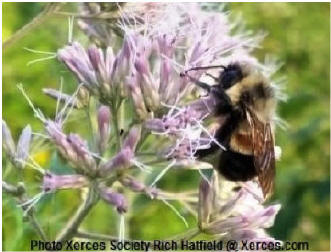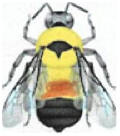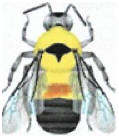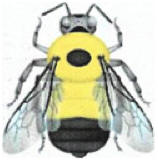 (2/27) The Bombus affinis, communally known as the Rusty Patched Bumble Bee, historically a native to Maryland, has been recommended to be placed on the endangered species list by the U.S. Fish and Wildlife Service. This coupled with the apparent extinction of the Franklins Bumble Bee on the west coast raises
concerns for the continued health of our native pollinators.
(2/27) The Bombus affinis, communally known as the Rusty Patched Bumble Bee, historically a native to Maryland, has been recommended to be placed on the endangered species list by the U.S. Fish and Wildlife Service. This coupled with the apparent extinction of the Franklins Bumble Bee on the west coast raises
concerns for the continued health of our native pollinators.
The Rusty Patched Bumble Bee was once very common throughout its range from the upper Midwest east to the Atlantic Coast from Maine south through the Carolinas into Georgia, Eastern Tennessee and Kentucky. Its population has drastically declined in 87% of its historical range. Many bee surveys have been conducted since 2003 trying to find the Rusty Patched Bumble Bee,
but only a few have been found in the remote areas of its historic range.
 The Rusty Patched Bumble Bee was once an excellent pollinator of our wildflowers, blueberries, tomatoes, cranberries, plum, apple, alfalfa and onion seed. Now they need our help.
The Rusty Patched Bumble Bee was once an excellent pollinator of our wildflowers, blueberries, tomatoes, cranberries, plum, apple, alfalfa and onion seed. Now they need our help.
Here are some things we can do to help preserve these and other valuable pollinators:
1. Provide native flowers in your home garden to provide nectar and pollen as a food supply. The non-native flowers prevalent in many home gardens often provide very little nectar and pollen for pollinators to use as food. Suggested native flowers for this area include Coreopsis, Smooth Penstemon, Wild Indigo, Butterfly Milkweed, Joe Pye Weed, Purple Cone Flower,
Blazing Star, New England Aster for more suggested flowers for this area see the Xerces Society recommended list on the Xerces web site: http://www.xerces.org/wp-content/uploads/2014/09/MidAtlanticPlantList_web.pdf
2. Leave nest sites (e.g. abandoned rodent burrows and bird nests tuffs of un-mowed grass) in your yard.
3. Donít pull dead flowers in the fall leave them until planting time next spring. These areas will provide hibernation sites for over-wintering queens.
4. If you feel you must use insecticides be very careful when applying the insecticides, read the label closely following application instructions and amounts to use. Apply early in the morning or late afternoon when bees are less active. Best of all use no insecticides.
5. If possible, convert large open areas into native meadowland instead of mowing.
If you see a Rusty Patched Bumble Bee please photograph the bee and contact the Xerces Society with the information concerning the sighting at the Xerces Society web site: info@xerces.org/bumblebees
Identifying Bombus affinis (Elaine Evans and Rich Hatfield, The Xerces Society xerces.org)



Worker Male Queen
Workers and males have a distinctive rusty brown patch on the front half of their second abdominal segment. The hair on their heads is mostly black. On the thorax, black hairs extend from a central patch in the middle of the thorax out towards the wings and centrally in a narrow V towards the rear. Queens are similar to workers except they are larger in size and do not
have the rusty patch on the abdomen.
Read other articles on birds, wildlife & beneficial insects
Read other articles by Ronald Dudley